TsugaPhiles,
The climb of the Usis hemlock in Cataloochee went as planned
yesterday
(2/15/2007). We entered the valley with thick hoarfrost covering
the ridges
and a light snow falling in the brisk 9 degree air. Jess Riddle,
Jason
Childs, Josh Kelley and I comprised the team. As some of you may
recall, the
name "Usis" is a Cherokee word for antler. This name
was chosen due to the
huge reiterated limbs composing a significant portion of the
crown. After
being immersed in the canopy for 6 hours I firmly believe it is
a fitting
name.
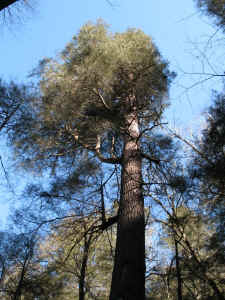
Literally within a few hundred yards of the conservation area we have been
treating for HWA we spotted a huge hemlock in a gorgeous rich cove. Jess
initially thought it was one he had previously seen but when we got closer
realized it was a new tree.We decided to name it Usis, Cherokee for "antler". An "elk highway" literally crosses the base
of the tree (well fertilized, too.) and we saw several elk while surveying
the ridge. The reiterations look like antlers so for now we will see how the
name fits. |
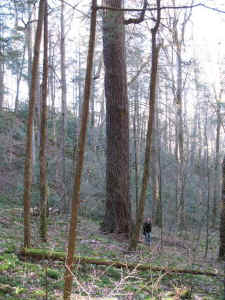
The trunk is slowly tapered and stout even up to the
top. Jess taped the trunk to 60.1" diameter. Aggressive
treatments should allow this tree to recover as it is in fairly good health
and has not fully defoliated yet. |
To give you
an idea of the crown, imagine this: a huge canopy perhaps ~110
feet in length and ~50 feet wide at the widest point. Supporting
this huge
crown is a stem 5 feet in diameter and over 170' tall. The odd
thing is the
crown is otherwise normal in dimension for a tree this size but
it is offset
from the trunk 15-20 feet.
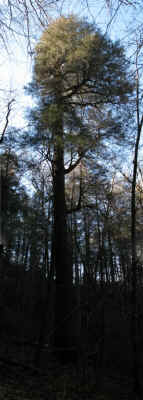
Usis from the side showing the reiterations. This monster of a tree has one of the most
gnarly, reiterated crowns we have seen yet. It has HUGE reiterated limbs
even up to 130' or so. |
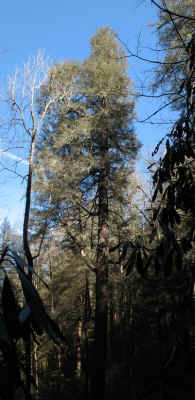
Usis from the front. Within ~200 yards grow two more trees over 160'
tall.
I climbed both of these trees last week, with the largest reaching 1270
cubes. The taller tree, over 168', was slender and only scaled 585 cubes. |
In order to support this huge
structure well away
from the trunk this tree has grown multiple, massive upturned
limbs that
have sprouted new trunks, some over 40' tall. These structures
allow for the
canopy to extend farther than an ordinary descending branch
would. Two of
the big reiterations are actually fused; one of which likely has
a path
length of continuous, non-vertical wood close to 50' from the
trunk. We do
not know what event caused such a one-sided crown to form in
such stark
contrast to other big hemlocks.
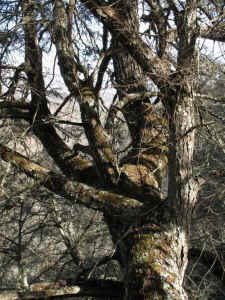
ConFUSEion |
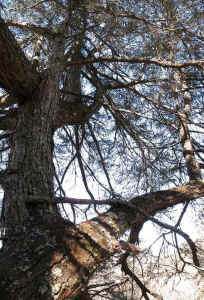
Mass Confusion |
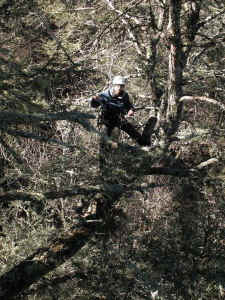
Jason Mapping Reiteration at 124 feet |
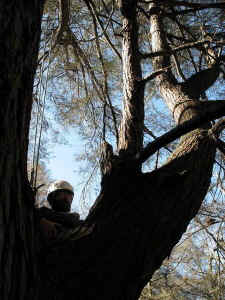
Jason on an Antler |
Jess and I
felt certain this tree, which was just discovered two weeks ago,
would be a big one, easily exceeding 1300 cubic feet of trunk
volume. This
suspicion was confirmed when I tried to set my climbing rope on
a stout
reiteration; I was not able to throw the throw bag high enough
due to the
height of the structure. Since I can routinely throw 80-90 feet
the size of
the tree became obvious, as it looked quite big at that point. I
switched to
a lighter bag and got the line set and headed up. While
ascending and
setting the reference tape straight up the trunk, I had to
zig-zag my way
up, dodging the huge reiterations- some over 1.5 feet thick.
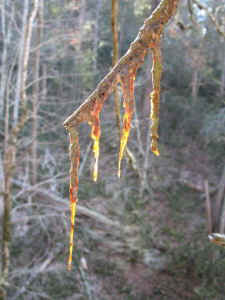
Elk Snot |
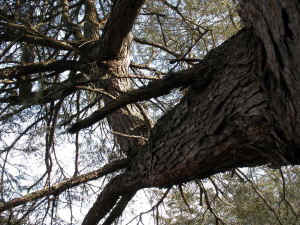
Fused Reiteration from Below |
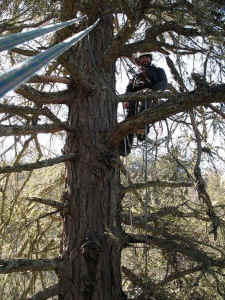
Jason at 135 feet |
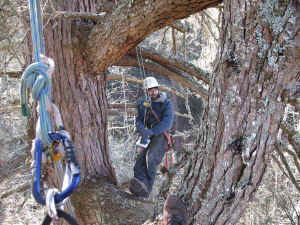
Jason in the Window of Wood at 100 feet |
I was not
sure exactly how tall this tree would be, but my two laser shots
from different positions were 172.5' and 172.9'. This was the
first tree I
have climbed and tape-dropped that was measured with my new
equipment. Jess
had calculated a slightly lower height with his gear so I was
not sure what
would result. After I found a straight path for the tape through
the gnarly
upper trunk, I found the top to be very stout and was able to
actually touch
the topmost sprig (and set a new personal tie-in height record
of 169').
Fellow climber Jason Childs had joined me by this time and he
helped set the
tape at the proper height while Jess and Josh Kelley zeroed the
base. Well,
a loud ENTS yelp resounded in Nellie Cove as the tape drop was
read- a new
height record of 173.1 feet! The previous record of 172.1' was
set just last
week!
The height of this tree, though seemingly not much more than a
150-160 foot
tree more typical of what I climb, became apparent as we
descended the trunk
and recorded incremental girths for the volume calculations. I
had to ask
Jason if we really were 150' off the ground when the trunk was
one foot
thick. And I asked again, when at over 135' up the diameter had
swelled to
over 20 inches. What's more, one of the reiterations originated
at 124' up
with a diameter of over 11". This seemed awfully big for so
high up, and
after extending outwards for 10 feet it turned up and ascended
to a tip 149'
above the ground.
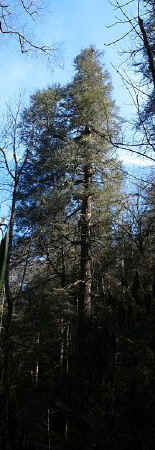
Whole tree with Will in Top - photo by Jess Riddle |

Fusion Stitch |
The complex
array of the multiple large reiterations, which by the way were
almost perfectly aligned on the same azimuth, combined with the
mid-teens
temperature to confound our measurements. In our cold delirium a
top we
noted as a prong of a large reiteration below would turn out to
be an
entirely new one from even farther below. To add more confusion
(con-FUSE-ion) two of the huge reiterations were fused and some
parts
belonged to one limb system and some were parts of another. We
had to do
some detective work to figure out the proper section to map.
This was a
first, as was literally crawling on hands and knees across a
wide hemlock
limb over 90 feet up without fear of falling (I was roped in of
course, Mom
;). The bottom line is this tree was huge, complex and
challenging.
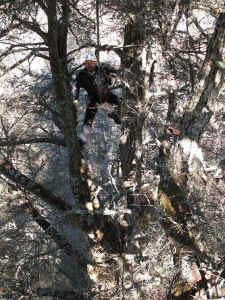
Will deciphering the fused limbs |
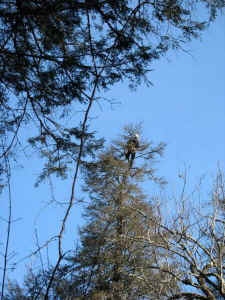
Will in top - photo by jess Riddle |
Jason and I measured and mapped the 10 largest reiterations from
trunk
origin to terminal tip on every significant limb >~5"
diameter. It was
tedious but well worth it in the hopes that Dr. Robert Van Pelt
will draw
the tree in his superb scale renderings (check out:
http://www.forestgiants.com
<http://www.forestgiants.com/> ). The data also
allow a fairly accurate determination of the volume of these
structures. Dr.
Van Pelt has found a high correlation in trunk volume and
reiteration size
in redwoods; lots of reiterations equate to lots of trunk
volume.
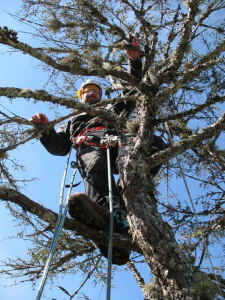
Will near the top |
The Usis tree may support this finding as it is one of the
largest hemlocks
Jess and I have documented in the Tsuga Search Project. The main
trunk was
stouter than either of us imagined. The diameter at breast
height (4.5') was
big, but not exceptional. What was exceptional was the slow
taper of the
trunk, the extreme length of the trunk and a record 9'7"
girth at 100' up.
All these factors combined to produce a trunk volume of 1379
cubic feet,
just 6 cubes less than the largest known in the national park.
However, much
to my surprise (again) the reiteration volume tallied up to an
astonishing
154 cubes of wood! Thus, Usis has a combined structural volume
of 1533 cubic
feet. The current volume record is the Cheoah Hemlock in
Highlands, NC at
1564 cubic feet, including reiterations.
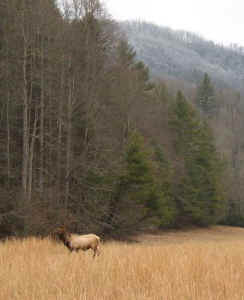
Shot of an elk taken a couple weeks previously
near the location of the Usis hemlock |
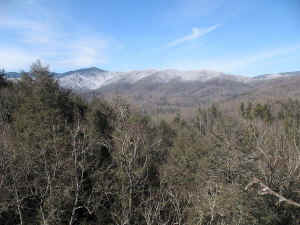
View from the top |
To me, the Usis Hemlock summarizes, in one tree, the
superlatives of the
species, Tsuga canadensis. It is an ancient tree with extreme
character,
height and mass. It grows in the wild, rich slopes of the
southern
Appalachian treasure of Great Smoky Mountains National Park. I
feel
fortunate to be in a situation to document trees such as the
Usis Hemlock,
and attempting to preserve for future generations the grandest
examples of a
regionally vanishing tree. For those holding your breath, the
Usis Tree is
in massive decline from hemlock woolly adelgid, and is unlikely
to respond
to conventional treatments- at least promptly enough to recover
to its
former glory. Large sections of the crown are already dead and
very few
needles remain. However, it has not yet produced a second flush
of twigs
yet, so provided enough buds survived the first HWA attack and
treatments
are effective, it may survive. It is hard to imagine such a
massive tree
succumbing to those little sucking bastards. What an utterly
undignified
death.
Will Blozan
President, Eastern Native Tree Society
President, Appalachian Arborists, Inc.
|